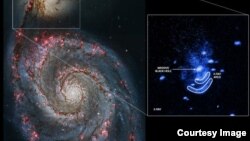Black holes, which have a voracious appetite, can suffer indigestion, according to new research.
Researchers at the University of Texas, San Antonio say they have discovered a massive “galactic blast,” or “burp” coming from a giant black hole some 26 million light years away.
Around the black hole, a large spiral galaxy, NGC 5194, is colliding with the smaller galaxy, NGC 5195. In the resulting maelstrom, the researchers believe gas is being funneled toward the black hole. The massive influx of material caused the burp, which is believed to contain enough matter to create new stars.
Astronomers call the outburst “feedback.”
“Apparently, black holes can also burp after their meal,” the University of Texas’s Eric Schlegel, who led the study, told NASA. “Our observation is important because this behavior would likely happen very often in the early universe, altering the evolution of galaxies. It is common for big black holes to expel gas outward, but rare to have such a close, resolved view of these events.”
The phenomenon must have played a role in the formation of the early universe, researchers said.
"The black hole's behavior may be a local example of events that commonly took place when the universe was much younger. That makes this observation potentially very important," Schlegel said.
Using NASA’s Chandra X-ray telescope, the researchers saw two arcs of gas with a thin layer of relatively cool hydrogen gas. This, they say, suggests the hotter gas entered the cooler gas like a snowplow.
“This is the best example of snow-plowed material I’ve ever seen. This is clearly a way of ejecting gas from a galaxy,” Schlegel, told the American Astronomical Society at their meeting in Kissimmee, Florida, on Tuesday.
The findings could change how black holes are viewed.
"We think that feedback keeps galaxies from becoming too large," said co-author Marie Machacek, astrophysicist at the Harvard-Smithsonian Center for Astrophysics. "But at the same time, it can be responsible for how some stars form, showing that black holes can be creative, not just destructive."
The paper was published in The Astrophysical Journal.
